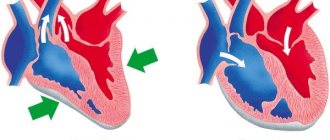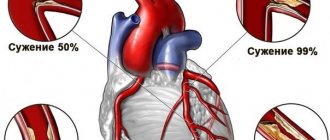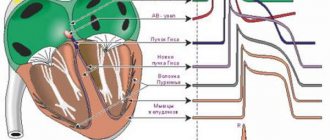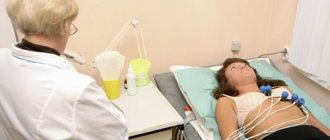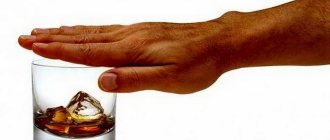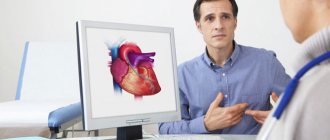0
Author of the article: Marina Dmitrievna
2017.07.26
12 361
Diagnostics
The main method for assessing the performance of the heart muscle is taking an ECG. Thanks to this technique, doctors learn not only about the presence of pathologies in the cardiovascular system, but also about the reasons that caused them. Few patients know how this procedure is performed and what preparatory measures are needed before the study.
ECG: what the study will show and why it is needed
An ECG is a non-invasive study of the work of the heart muscle over a certain time. The procedure is carried out using special electrodes that are attached to the chest at certain points. They capture the subject's heart impulses, amplify them and transmit them to a galvanometer. These signals are recorded by a recording device in the form of jagged lines.
The height and duration of the teeth must correspond to the established norm. Any deviations indicate the development of heart problems. An experienced doctor is able to make the correct diagnosis based on the results of the cardiogram.
Interpretation of ECG indicators
On the tape, the curve obtained after taking the cardiogram has 5 teeth. They occur with sequential contraction of the atria and ventricles. The following designations are accepted:
- The P wave is an indicator of the work of the right (first half) and left atrium.
- P Q – interval of impulse passage to the ventricle along the Hiss bundle.
- QRST - complex occurs during contraction of the ventricles, while the highest R wave reflects the excitation of the ventricular myocardium, and Q and S are the partitions between them, T - occurs during the period of myocardial recovery after systole.
Teeth and intervals
Normal in adults
A doctor can fully evaluate the electrocardiogram, since making a diagnosis requires knowing the symptoms of the disease and data from other research methods (blood tests, ultrasound, echocardiography). The general characteristics that a specialist evaluates in a healthy person are as follows:
- The rhythm of contractions is from 60 to 80 per minute.
- The size of the intervals should not exceed normal values, or be shorter than average values.
- Electrical axis - normally R exceeds S in all leads except aVR, V1 - V2, sometimes V3.
- The ventricular complex is no more than 120 ms.
- T is positive and longer than the QRS complex.
ECG (normal)
During pregnancy
As the uterus grows, it raises the dome of the diaphragmatic septum and after 24 - 24 weeks the apex of the heart moves to the left. This is reflected in the electrocardiogram by an increase in the amplitude of R in the first lead, and S and Q in the third lead, the ventricular complex decreases along with the ST segment. Changes in conduction through the heart muscle are also associated with the influence of hormones produced by the placenta.
Characteristic features:
- Shift of the heart axis to the left.
- T biphasic and negative in the right chest leads.
- The ventricular complex is wider than normal.
- Rapid rhythm, single extraordinary contractions.
Respiratory arrhythmia in pregnant women
What will the ECG show?
The study, as a safe and effective procedure, is prescribed to all people without exception. An ECG allows you to promptly identify cardiovascular pathologies and select the correct treatment.
A cardiogram makes it possible to determine the following features:
- heart rate;
- myocardial wall thickness;
- disturbance of potassium and magnesium metabolism;
- myocardial damage;
- quality of the pacemaker;
- source of pain in the heart area (caused by heart disease or other pathologies).
If the patient has been properly prepared for taking an ECG, the procedure allows you to diagnose:
- arrhythmia;
- tachycardia;
- cardiomyopathy;
- coronary heart disease;
- pericarditis;
- heart attack
Indications and contraindications for ECG
Heart rhythm disturbance is an indication for an ECG
Indications for ECG:
- Heart rhythm disturbances
- Changes in blood supply to the myocardium (muscle layer of the heart)
- Suspicion of myocardial damage
- Thickening of the heart wall (hypertrophy)
- Contractility and conduction disorders
- If you suspect a heart attack
Contraindications:
It has no contraindications. The exception is people with a strong curvature of the chest, as well as people suffering from inflammatory processes on the skin in the area where the cardiograph electrodes are applied.
Frequency of the study
During an ECG, sensors attached to the chest do not have any effect on the body. Their only task is to capture and transmit cardiac impulses. That is why an ECG cannot harm a person, even if the study is carried out daily.
Doctors consider the following frequency of ECG to be justified:
- Healthy population under 40 years of age . For such people, one study per year is enough.
- People with chronic illnesses . For patients suffering from cardiovascular diseases, an ECG schedule is prescribed by the attending physician. It is generally recommended that the survey be conducted quarterly.
- Workers associated with risk . Doctors advise people whose profession is associated with risk (for example, the Ministry of Emergency Situations) to undergo examination every six months.
- People who have crossed the 40-year mark . This population needs cardiac testing every 3-6 months. The frequency of an ECG depends on the state of health and is determined solely by the doctor.
An ECG is mandatory for pregnant women. Expectant mothers experience hormonal changes. These disturbances affect the blood circulation process. Therefore, the ECG cannot be ignored. The frequency of the study depends only on the woman’s condition and the course of pregnancy.
What can you learn from a cardiogram?
ECG allows you to determine the location of cardiac ischemia
The human heart, like all mammals, consists of 4 chambers: two atria and two ventricles. The cardiac septum is complete, which prevents arterial and venous blood from mixing.
Blood is expelled from the atria into the ventricles, then released into the circulation. The heart contracts rhythmically due to impulses passing through the conduction system. It begins with the sinus pacemaker.
Next, the electrical impulses are sent down and cover the entire heart muscle. Due to this, contraction (systole) occurs. The emergence and propagation of excitation is recorded by the device.
The electrocardiogram appears on paper or on a display in the form of a graphic image. Analyzing the result, specialists can identify the following:
- Heart rate and regularity
- Localization and size of ischemia
- Toxic heart damage
Carrying out this diagnosis and correct interpretation of the cardiogram will allow you to find out the cause of the deviation in the heart’s function and identify the following diseases, such as:
- Angina pectoris, heart attack
- Myocardial hypertrophy
- Disturbances in the electrolyte composition of the blood.
On the eve of the study
Patients who are prescribed an ECG must begin preparing for the examination the day before diagnosis with the following activities:
- Complete peace of mind . On the eve of the ECG, it is necessary to completely protect yourself from stressful situations if possible. Experiences and high anxiety can distort the results of a cardiogram.
- Full sleep . Before the study, be sure to get enough sleep. In a tired body, the heart functions in an enhanced mode.
- Quitting alcohol . It is strictly forbidden to drink alcohol before an ECG. Alcohol causes the blood to thicken, causing the heart to work much harder.
- Proper nutrition . You should not overload the body with too heavy dinner and breakfast before the ECG. It is advisable to exclude fatty and heavy foods from the diet. Otherwise, the body will devote all its reserves to digesting food, and the heart will be forced to work “for wear and tear.”
- Refusal of physical activity . In order for the cardiogram to show reliable results, doctors advise not to exercise on the eve of the ECG, and to do without exercise or jogging in the morning.
- Elimination of thermal procedures . It is not recommended to visit saunas or steam baths before taking an ECG. Doctors advise against taking a bath. Any thermal procedures can increase blood circulation and heart activity.
- Taking medications . The day before the examination, it is necessary to completely avoid taking medications, except those that are prescribed on a regular basis. The doctor must know about the latter.
Reasons for unreliable results
The following factors may affect the reliability of the results obtained:
- improper connection of wires to various parts of the body;
- applying lotions and creams to the skin to form a protective film;
- emotional turmoil suffered the day before;
- taking certain groups of drugs - antidepressants, sedatives and nootropics;
- improper preparation for an ECG.
Before the ECG, it is worth warning the doctor about unusual situations that have occurred in your life in the last few days. The specialist will decipher the results obtained taking into account the recently experienced stressful situation or reschedule the study for another day.
The heart rate recording technique itself is quick and easy for an experienced cardiologist. The ECG is performed in a ventilated room (the optimal room temperature is no less than 18 and no more than 24 degrees). During the test, patients have to undress, and the cold can negatively affect a person’s emotional state. The key to a successful procedure is the patient’s complete calm.
The following activities will help ensure a relaxed state:
- 15-minute rest for the person before and after the procedure;
- lying on your back during sensor installation;
- even breathing.
You should know! You do not need to eat before the procedure. It is advisable that at least 1.5-2 hours pass from the moment of eating to the start of the examination. If you feel hungry, you are allowed to eat easily digestible foods: fruits, vegetables or fermented milk drinks.
On the day of the ECG
Proper preparation for taking an ECG includes the following recommendations:
- Giving up coffee . On the day of the study, it is advisable to exclude caffeine-containing drinks from your diet. This applies to strong coffee, tea, and some types of soda. It is strictly forbidden to take energy drinks.
- Avoiding the use of creams . Before the procedure, you should not apply greasy lotions or creams to your chest. This cosmetics can form a film on the surface of the body, with which it is quite difficult for sensors to contact.
- To give up smoking . 2-3 hours before the ECG you need to completely stop smoking. Nicotine causes severe vasoconstriction, leading to excessive heart activity.
- The right clothes . Sensors that record heart impulses are placed in the chest area, as well as on the wrists and calves. These areas of the body must be exposed before the procedure. It is advisable to choose clothing that will allow you to correctly install the electrodes and will not put pressure on your body.
Cardiologists advise arriving 15-20 minutes before the ECG. It is necessary to sit under the office and breathe deeply to restore the heart rhythm, increased by walking.
Preparation for the procedure
If a person knows in advance when the procedure is, then it is better to prepare for it 1-2 days in advance. Many will be surprised, because no one talks about this. The secret is simple - during this time the patient must calm his heart as much as possible.
Advice! Get an ECG from a qualified doctor who can read the information.
Often, due to a medical error, people are treated for diseases of the cardiovascular system that are completely different from those that they have. If necessary, to obtain detailed information, the patient undergoes echocardiography, Holter monitoring, vascular ultrasound, etc. It is impossible to draw a conclusion based only on ECG data.
Preparation
The first stage of preparation should be the choice of a medical institution or doctor who performs the procedure.
To take a quality photo, you need to know how to improve the result. To do this, the patient must follow the following recommendations:
- Avoid alcohol 1-2 days before the procedure.
- The day before the procedure, do not drink caffeinated drinks.
- If possible, avoid heavy physical activity on the eve of the ECG.
- Minimize the stress factor.
- In the morning before the procedure, take a warm shower (clean skin has better conductivity).
- If men have heavily developed hair on their chest, then shave it so that the contact of the electrodes is better.
- Women should avoid applying greasy creams or balms to their bodies; their skin should be clean.
- Before the procedure, do not take medications to ensure accurate results. Before the ECG, the doctor will clarify which medications to stop for a while.
- While waiting for the procedure, calm down. To do this, inhale deeply and exhale slowly for 10 minutes.
- If necessary, take a bedding towel with you.
These are preparatory moments that help the device obtain accurate information. With such preparation, the data obtained is as true as possible, which is what a cardiologist needs.
How to take an ECG (guide for beginners)
This is a real quest that needs to be solved. To make life easier for everyone who wants to undergo a free ECG, I am publishing this post.
1) First, you need to come to your clinic at the time when your pediatrician is visiting. Please note that you need a medical card, shoe covers and an insurance policy, you do not need a coupon.
2) Come in with the next unfortunate patients in line and say: “I’ll see the nurse.” Don’t forget the spell “Me to the nurse.” This will save you from curses.
3) We go into the office and say that we need a referral for an ECG. If you need this for the military registration and enlistment office, then you will be lucky - you will not be referred to a cardiologist. Otherwise, we get a referral to a cardiologist.
4) The doctor will take your card and paste a “referral” on it. Don't believe it. This is not a direction. This is a red herring.
5) We go to the head of the department. Luck is on your side again if it takes place on the same day at the same time.
6) Explain the situation. If (Oh, heaven!) she has numbers, then everything is great, we take the number. Otherwise, we leave our data and wait, wait, wait. You can scare her with the words “urgently”, “need the day after tomorrow”, but this is unlikely to help.
7) Important point! If she has numbers, then we take the number and direction. The present. This is a gray piece of paper, half the size of a regular sheet, with two stamps “ECG” and “Polyclinic No. “. You won't be accepted without it. If they say that you will be accepted according to the “referral” from point 4, do not believe it. Insist and take real direction.
 If there are no numbers, and they still get through to you after a few days, then go to the clinic and get a referral.
If there are no numbers, and they still get through to you after a few days, then go to the clinic and get a referral.
9) On the day of the appointment, we take with us a referral, a card with a pseudo-referral, an insurance policy, SNILS, a passport, shoe covers, and joyfully go to the clinic, which is written in the direction.
10) In the “Inquiry” we ask which office to go to.
11) We get to the office and enter at the appointed time.
12) Ta-dam! You did it! Congratulations!
No duplicates found
I have signed up and am waiting for a guide on how to tie your shoelaces, drink some water and use the elevator for its intended purpose.
The military registration and enlistment office registers conscripts from the age of 16; this is not yet an adult clinic, if anyone doesn’t know.
In paragraph 6 it is better to say: “It should have been yesterday/the day before yesterday”
In our city, 2 years ago, this pleasure in a paid clinic cost 250 rubles (without decryption). I didn’t even bother running around the offices, I called and made an appointment for a convenient time. Saving this money is not worth the nerves spent running around offices, standing in lines and barking grannies.
Recommendations for training
The use of ECG as a heart diagnosis is widely known. Moreover, this procedure can be carried out in different ways. Today, the following types of diagnostics are available:
- classic ECG, which is performed most often;
- inside food ECG. This study is not prescribed as often as the previous type of cardiography. Represents the introduction of an electrode into the esophagus;
- Holter ECG. This type involves conducting cardiography over a long period of time; as a rule, the procedure lasts about a day;
- Bicycle ergometry is represented by cardiography, which includes increased load. Usually performed to diagnose athletes.
The process of preparing for any type of diagnosis does not imply separate specific activities. However, there are some conditions that must be observed by the patient.
Doctors recommend before an ECG:
- have a good rest;
- avoid stress if possible;
- do not eat large amounts of heavy food. If intra-nutritive examination is carried out, it is recommended to come to the procedure on an empty stomach;
- you need to reduce your fluid intake. This recommendation applies to 3-5 hours before the procedure;
- Before the examination, you need to relax as much as possible and pay attention to breathing restoration;
- take a shower without any cosmetics;
- You should come to the procedure in comfortable, loose clothing, which will allow you to easily expose the required area.
